The Early Years of Brain Imaging
By David Warmflash
In the early 20th century, neurosurgeon Walter Dandy developed the first techniques for in vivo observation of the central nervous system.
In the early 20th century, neurosurgeon Walter Dandy developed the first techniques for in vivo observation of the central nervous system.

At the turn of the 20th century, the newly discovered uses for x-ray technology in medicine and the emerging field of neurosurgery helped lead to the rise of a pivotal figure at Johns Hopkins School of Medicine, Walter Dandy. A protégé of the well-known neurosurgeon Harvey Cushing and later (after Dandy and Cushing had a falling out) of the well-regarded surgeon William Stewart Halsted, Dandy entered the field in 1910 after finishing medical school at Johns Hopkins at the age of 24. He would spend the rest of his career at the same institution.
Dandy completed general surgery training in 1918, with another neurosurgery pioneer, George J. Heuer, stepping in to guide him. Dandy’s training in Halsted’s general surgical service turned out to be a boon, because he was able to reapply innovations from other fields of surgery to neurosurgery. Under Halsted, he had already shown his promise by adapting an endoscope used in urology for looking inside the brain.
Dandy’s various contributions included a plethora of techniques, such as aneurysm clipping, resection of cerebellopontine angle tumors, hemispherectomies, procedures for treating fluid buildup in the brain, and the first use of brain endoscopy. As Dandy worked on tragic cases of brain tumors and hydrocephaly—a dangerous accumulation of fluid in the brain—he realized that the system of canals where cerebral spinal fluid is produced and through which it flows, the cerebral ventricular system, could be used to view the brain in ways that would open up new treatments and could save some of his sickest patients’ lives.
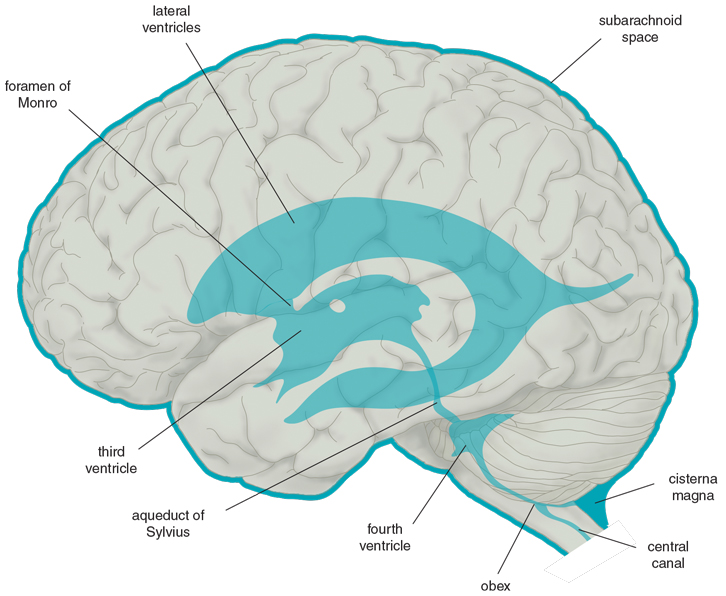
Barbara Aulicino
Dandy is particularly famous for his work advancing the understanding of the anatomy and physiology of the flow of cerebrospinal fluid. As a result of this exploration, his invention of the first brain imaging techniques, air ventriculography and then pneumoencephalography, became the gold standard for several decades. Dandy’s early brain imaging techniques were invasive and risky, and they fell by the wayside in the 1970s once computed tomography (CT) scans and, later, magnetic resonance imaging (MRI) came on the scene. But this chapter in neurosurgery’s history shows the incredible challenges that came with attempting to capture the earliest glimpses of the whole brain in a living person.
Dandy began his career at a time when the study of cerebrospinal fluid and disorders related to it were a focus in his field, with rapid advances. German surgeon Heinrich Quincke described the first lumbar puncture in 1891. In their studies of meningitis in 1903 and spinal tumors in 1907, respectively, physicians Georges Froin and Max Nonne described cerebrospinal fluid blockages and compression. In 1912, physician William Mestrezat made the first comprehensive study of the chemistry of cerebrospinal fluid. In 1914, Cushing provided evidence that cerebrospinal fluid was produced by special secretory tissue in each ventricle, called the choroid plexus.
Cushing also worked out how the ventricular system is connected, showing that the cerebrospinal fluid flows from the choroid plexus to the subarachnoid space and venous sinuses. On each side of the brain is a lateral ventricle, each of which connects through a channel called the foramen of Monro to the single, third ventricle (see the figure above). The third ventricle, in turn, connects through the aqueduct of Sylvius (also known as the cerebral aqueduct) to the fourth ventricle, which drains into the central canal of the spinal cord—which is why cerebrospinal fluid can be accessed through a lumbar puncture.
Dandy was training under Cushing at the time when the study of cerebrospinal fluid was the latter’s focus, so the promising student became familiar with the ventricular system and diseases affecting cerebrospinal fluid. While working under pediatrician Kenneth Daniel Blackfan in 1913, Dandy and his mentor described the overproduction or obstruction of cerebrospinal fluid in this system in cases of hydrocephalus.
Dandy’s earliest work sought to understand cerebrospinal obstructions in the ventricular system in cases of hydrocephaly. Between 1914 and 1922, Dandy published 17 papers on hydrocephalus, a condition in which the cerebrospinal fluid does not drain properly, swelling the brain. At the time, this condition was often fatal. Dandy performed 381 surgeries on hydrocephaly patients between 1915 and 1946. Before Dandy developed techniques for imaging the brain, 50 percent of patients treated with surgery for hydrocephaly died, and those who did survive often died within a few months. Today, it’s rare to lose a patient after an operation for hydrocephaly, and survival after five years is about 90 percent.
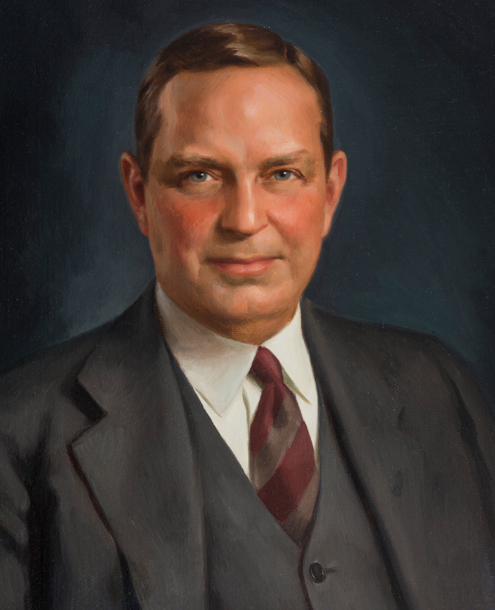
The Chesney Archives of Johns Hopkins Medicine, Nursing, and Public Health
Though not so revealing of soft tissue, x-rays were extremely valuable for pulmonary imaging in the early 20th century, when pulmonary tuberculosis was widespread. While working on Halsted’s general surgery service and looking at a chest x-ray, Dandy noticed a particularly radiolucent region on the film, under the patient’s diaphragm, indicating the presence of air. The presence of air was not critical to the patient’s case, so no one else was interested, but Dandy realized this meant that x-rays passed more easily through air than through tissues, and thus air could serve as a kind of negative contrast agent. Given that various liquids in use as positive contrast agents were toxic if circulated through the brain’s ventricular system, Dandy decided to try using air instead. Accustomed already to accessing the brain’s fluid-filled ventricular system through the skull with his endoscope technique, he reasoned that he could drain out the ventricles’ normal fluid—cerebrospinal fluid—and replace it with air.
Dandy first tried replacing cerebrospinal fluid in the ventricles with air in 1916, while completing his fourth operation on a patient with hydrocephaly. Dandy drilled holes through the patient’s skull as the route for sending air into the ventricular system—the air ventriculography technique. Dandy was interested both in tumors of the ventricles and in treating obstructive hydrocephalus. Both these issues can be treated most effectively when the tumors or blockage can be viewed and precisely located in the brain. Ventriculography allowed for earlier detection of hydrocephaly and better determination of where the blockage occurred. In a surviving ventriculogram from 1918 (see image below), an obstruction swelling the ventricle slightly in a three-year-old child with tuberculous meningitis is apparent, and the location of the obstruction causing hydrocephalus was identified. In this image, the foramen of Monro is even visible.
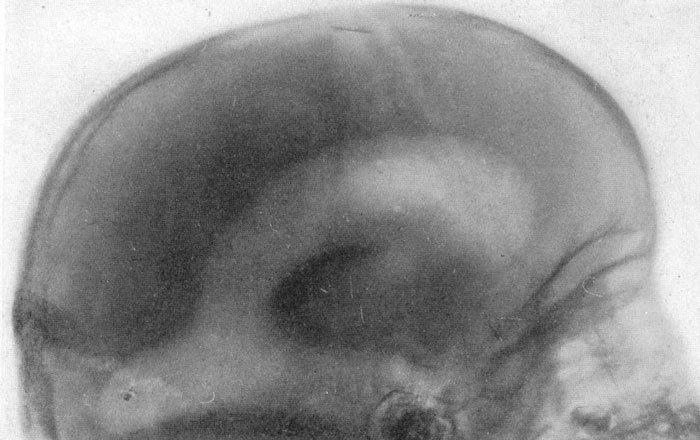
© 1918, © Lippincott-Raven
In 1919, Dandy started replacing cerebrospinal fluid with air via a lumbar puncture instead of through cranial burr holes. Taking x-rays of the brain after the lumbar air replacement technique and after moving the patient around in different ways, Dandy discovered that he could image the entire brain (see photo below and x-ray inset). This breakthrough is where the term pneumoencephalography comes into play. The technique worked because the injected air could be spread throughout the subarachnoid space, which is beneath the deepest layer of the meninges that surround the brain, and which bends around with all the brain’s curves and twists. Pneumoencephalography, which was later depicted in the 1973 horror film The Exorcist, required the patient to be flipped upside down and through different positions to enable gravity to get the air throughout the subarachnoid space. To do so, patients had to be sedated.
Prior to Dandy’s work, the combination of neurological examination and poor-quality x-rays could provide neurosurgeons with the locations of only approximately one-third of intracranial tumors. Dandy’s air-based innovations made it possible to see almost all of them.
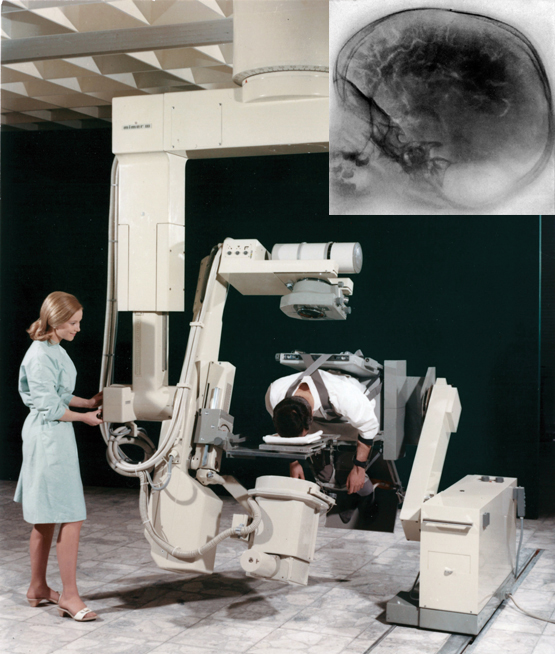
Siemens Healthineers Historical Institute
Air ventriculography and pneumoencephalography were dangerous, with potentially fatal outcomes. Mortality among patients receiving pneumoencephalography could be as high as 30 percent. At minimum, these procedures caused bad headaches, nausea, and vomiting. The decision to undertake these surgeries was serious. And although Dandy did not participate in such studies, some doctors used pneumoencephalography in disturbing and highly unethical ways: to study patients with schizophrenia, children with autism, or, in the case of Rudolf Lemke of the University of Jena in the 1940s, homosexual men. It’s no wonder that medicine was quick to abandon both techniques as soon as CT scanning came on the scene in the 1970s.
With all of Dandy’s fundamental contributions to neurosurgery, he also managed to apply his expertise to another realm of health care: sports medicine. While batting on June 1, 1940, protected only by a canvas baseball cap, Brooklyn Dodgers’ star 21-year-old shortstop, Pee Wee Reese, collapsed when struck in the head with a fastball. He returned to play several days later, allegedly with no major neurological damage, but other batters of his era commonly suffered traumatic brain injuries. From the late 19th century and into the mid-20th, brain injury was the most common reason for baseball-related death. Consequently, Reese’s and one of his teammate’s injuries triggered an effort by the Dodgers’ team management to develop batting helmets, a project that soon came to involve Dandy, an avid baseball fan as well as a recreational player.
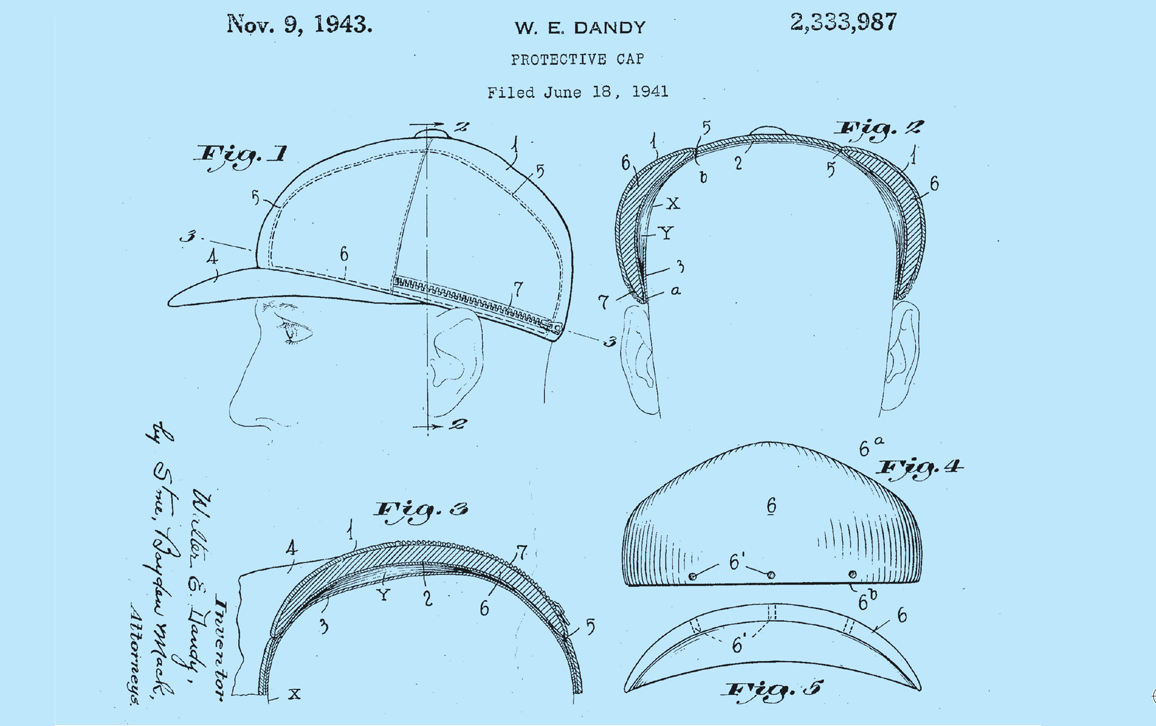
United States Patent and Trademark Office
Back in medical school, Dandy had captained the school’s baseball team. Then, in 1912, one of his first major surgical cases involved a cranial cyst that had developed after the patient had been struck in the head by a baseball. Dandy’s professional and personal interests both reinforced the need for better head protection in the sport. Subsequent to the summer of 1940, Dandy’s idea for an armored cap developed, inspired by horse jockeys’ helmets, with plastic padding on either side of the head. Major League Baseball introduced this protective helmet in 1941, just in time to protect another Dodgers rookie, Pete Reiser. When he was struck in the head in April 1941, his doctor called him “very lucky” to have a minor concussion rather than a fractured skull, thanks to Dandy’s helmet. Other teams soon followed the Dodgers’ lead.
This protective cap became standard headgear until 1952, when a new fiberglass and plastic resin helmet that provided full head coverage, securely fitted with leather padding, came on the scene. Clearly, Dandy’s efforts left an impressive legacy in multiple fields, from sports medicine to modern neurosurgery practice.
Click "American Scientist" to access home page
American Scientist Comments and Discussion
To discuss our articles or comment on them, please share them and tag American Scientist on social media platforms. Here are links to our profiles on Twitter, Facebook, and LinkedIn.
If we re-share your post, we will moderate comments/discussion following our comments policy.